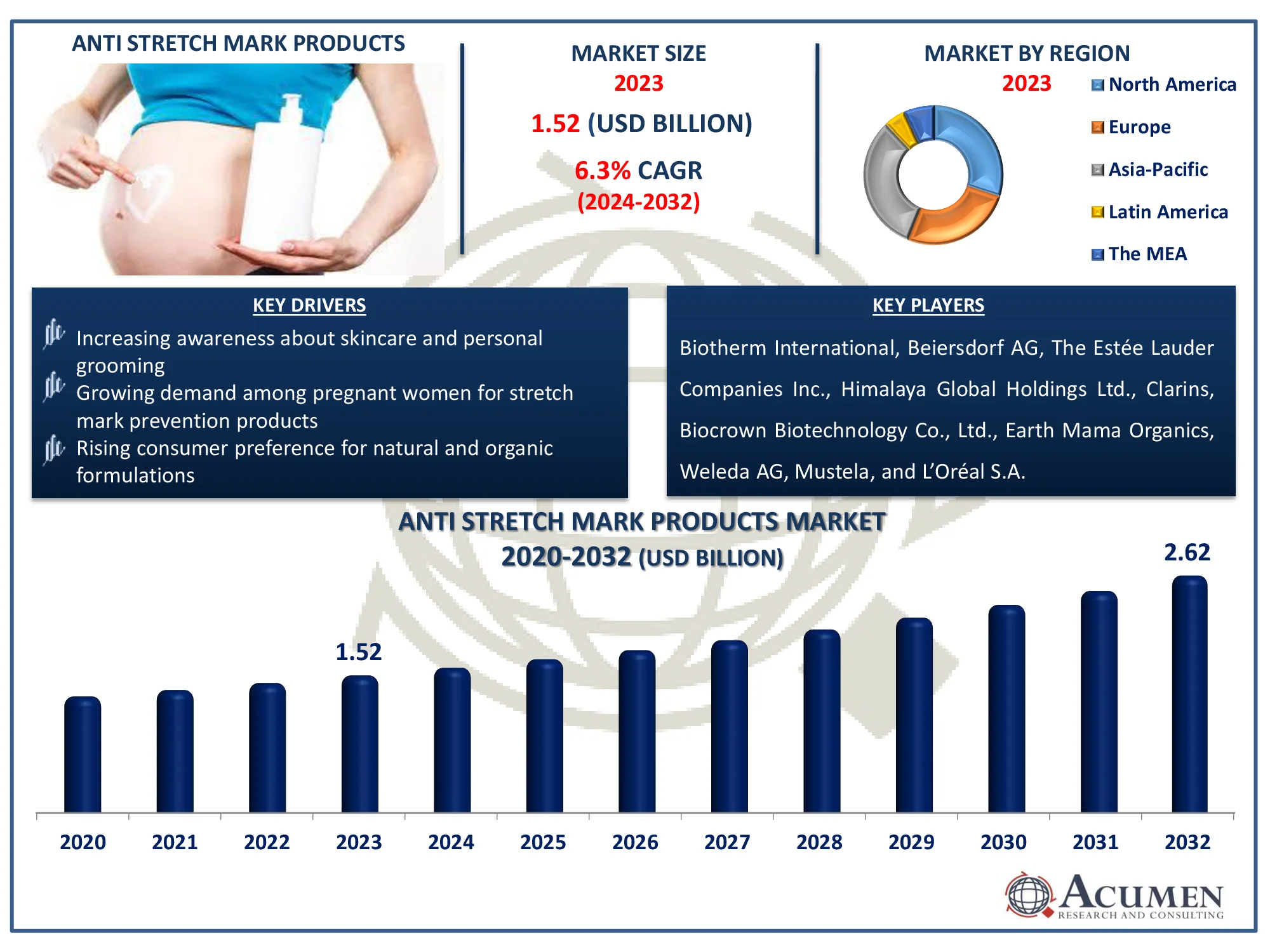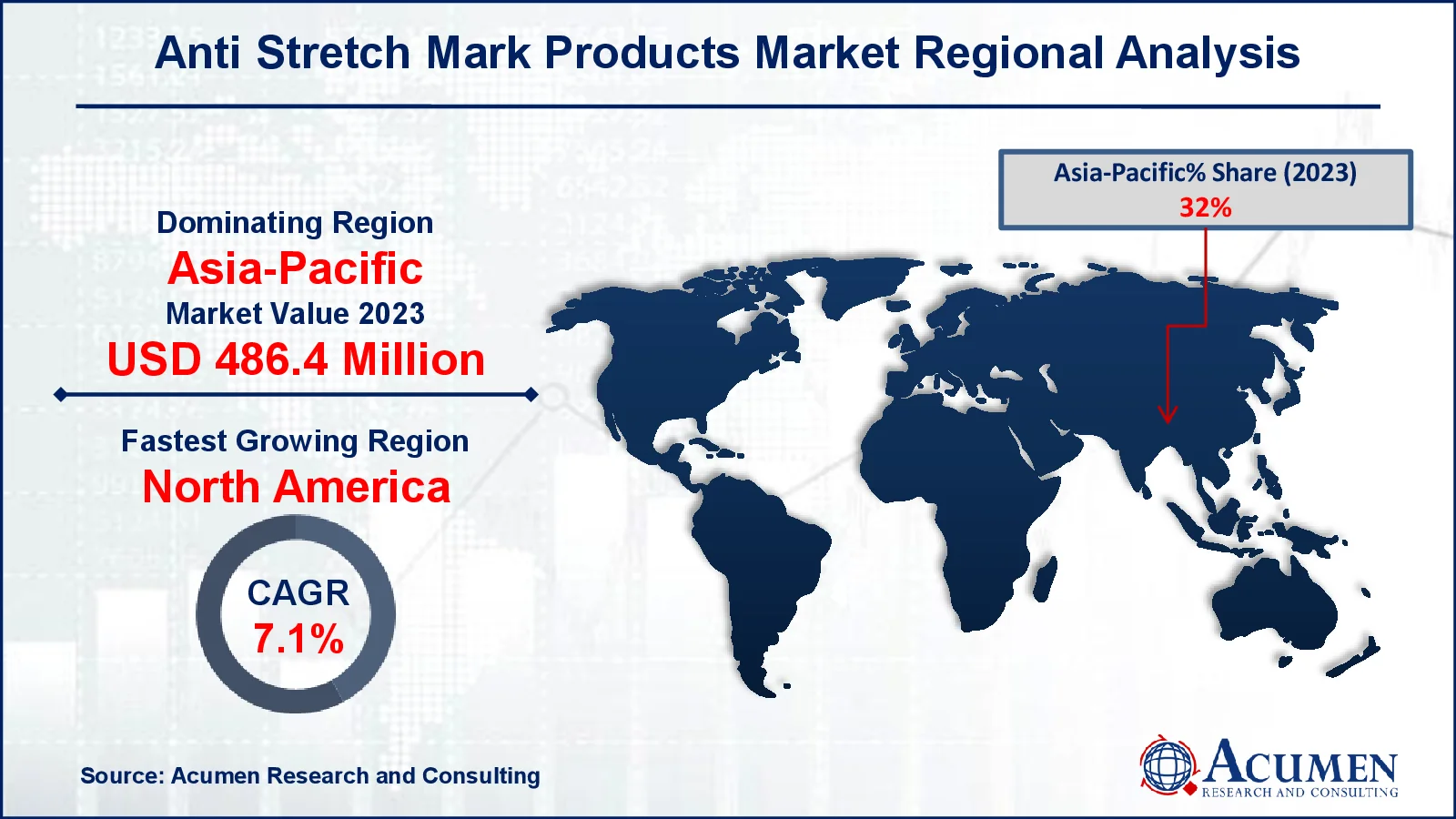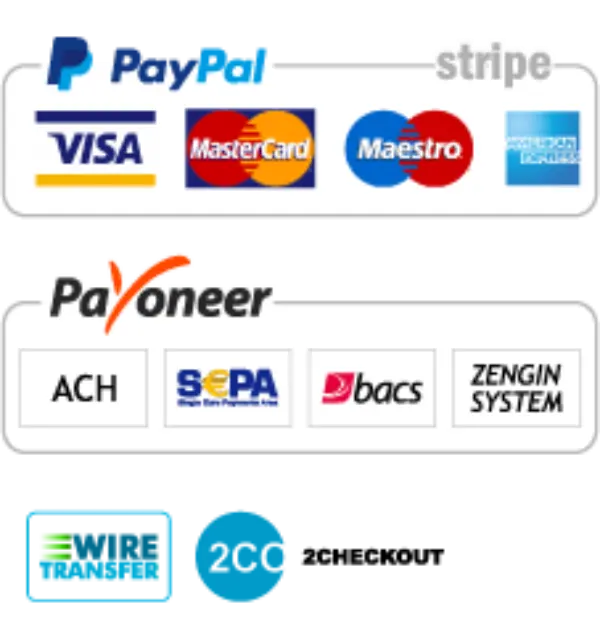Anti Stretch Mark Products Market Size (By Product, By End User, By Distribution Channel, and By Geography) - Global Industry, Share, Analysis, Trends and Forecast 2024 - 2032
Published :
Report ID:
Pages :
Format :
Anti Stretch Mark Products Market Size (By Product, By End User, By Distribution Channel, and By Geography) - Global Industry, Share, Analysis, Trends and Forecast 2024 - 2032
Report Coverage
- Industry Dynamics
- Market Size and Forecast Data
- Segment Analysis
- Competitive Landscape
- Regional Analysis with a Niche Focus on Country-Level Data
- High Level Analysis - Porter's, PESTEL, Value Chain, etc.
- Company Profiles of Key Players
- Option to Customize the Report As Per Your Specific Need
Request Sample Report
The Global Anti Stretch Mark Products Market Size accounted for USD 1.52 Billion in 2023 and is estimated to achieve a market size of USD 2.62 Billion by 2032 growing at a CAGR of 6.3% from 2024 to 2032.
Anti Stretch Mark Products Market Highlights
- The global anti stretch mark products market is projected to reach USD 2.62 billion by 2032, with a CAGR of 6.3% from 2024 to 2032
- In 2023, the Asia-Pacific anti stretch mark products market held a value of approximately USD 486.4 million
- The North America region is expected to grow at a CAGR of over 7.1% from 2024 to 2032
- The creams product accounted for 37% of the market share in 2023
- The hypermarkets & supermarkets distribution channel sub-segment captured 51% of the market share in 2023
- Personalized formulations targeting specific skin types and needs is the anti stretch mark products market trend that fuels the industry demand

Anti-stretch marks are a type of scar that develops on the skin when it stretches or shrinks rapidly. According to the National Institute of Health, Striae gravidarum (stretch marks that appear during pregnancy) affects 50 to 90% of women. This happens when the skin undergoes sudden stretching, causing the collagen and elastin that support the skin to rupture. As the skin heals, anti-stretch marks may appear. Hormonal fluctuations can also contribute to their development. However, not everyone will develop these thin bands of marks. Adolescents, particularly women, are significantly affected, but adolescent men also frequently report stretch marks. Additionally, prolonged use of corticosteroids on the skin can lead to their appearance.
Anti-stretch marks typically appear pink, purple, red, reddish-brown, or dark brown depending on skin tone and may feel raised and itchy. They are also commonly associated with aging. With millennials becoming more conscious about self-care, many are willing to invest in products that help reduce or reverse the signs of aging. Pregnant women and individuals undergoing weight loss treatments also seek effective solutions to remove or minimize stretch marks.
Global Anti Stretch Mark Products Market Dynamics
Market Drivers
- Increasing awareness about skincare and personal grooming
- Growing demand among pregnant women for stretch mark prevention products
- Rising consumer preference for natural and organic formulations
Market Restraints
- High cost of premium anti-stretch mark products limiting affordability
- Availability of alternative remedies such as home-based natural treatments
- Limited product penetration in rural and low-income regions
Market Opportunities
- Expansion of e-commerce platforms providing wider product accessibility
- Increasing demand in emerging markets with growing disposable income
- Product innovation, such as multipurpose formulations with anti-aging benefits
Anti Stretch Mark Products Market Report Coverage
|
Market |
Anti Stretch Mark Products Market |
|
Anti Stretch Mark Products Market Size 2023 |
USD 1.52 Billion |
|
Anti Stretch Mark Products Market Forecast 2032 |
USD 2.62 Billion |
|
Anti Stretch Mark Products Market CAGR During 2024 - 2032 |
6.3% |
|
Anti Stretch Mark Products Market Analysis Period |
2020 - 2032 |
|
Anti Stretch Mark Products Market Base Year |
2023 |
|
Anti Stretch Mark Products Market Forecast Data |
2024 - 2032 |
|
Segments Covered |
By Product, By End User, By Distribution Channel, and By Geography |
|
Regional Scope |
North America, Europe, Asia Pacific, Latin America, and Middle East & Africa |
|
Key Companies Profiled |
Biotherm International, Beiersdorf AG, The Estée Lauder Companies Inc., Himalaya Global Holdings Ltd., Clarins, Biocrown Biotechnology Co., Ltd., Earth Mama Organics, Weleda AG, Mustela, and L’Oréal S.A. |
|
Report Coverage |
Market Trends, Drivers, Restraints, Competitive Analysis, Player Profiling, Covid-19 Analysis, Regulation Analysis |
Anti Stretch Mark Products Market Insights
Obesity is becoming more prevalent worldwide as a result of changing lifestyles, changing eating habits, and increased consumption of fast food and high-calorie foods by consumers, particularly young people. According to the Centers for Disease Control and Prevention, the prevalence of obesity in adults was 40.3% from August 2021 to August 2023, with no notable differences between men and women. Adults aged 40 to 59 were more likely to be obese than those aged 20 to 39 or 60 and older. Obesity is mainly caused by overeating and inactivity. However, if people consume large amounts of energy, particularly fat and sugar, they acquire weight, which is referred to as obesity.
Furthermore, stretch marks may emerge as a result of hormonal changes that occur when a person gains weight. Stretch marks are created by skin stretching, which is influenced by hormone levels, particularly cortisol. According to the Mayo Clinic, cortisol generated by the adrenal glands weakens the skin's elastic fibers. Obesity may also create skin problems due to factors such as skin stretching, which can result in anti stretch marks. As a result, millennials are becoming increasingly mindful of their skincare, and they are prepared to spend more money on anti stretch mark products, which is driving the expansion of the anti stretch mark products market.
Furthermore, there is a growing knowledge of stretch mark products among women, as a result of which women get stretch marks during pregnancy. However, manufacturers are focusing on expanding their product portfolio by introducing new and sophisticated anti-stretch mark products. For example, in May 2024, a well-known cosmetic brand endorsed by Kim Kardashian launched a site-wide sale as part of its May Frenzy Sale. The Anti-Cellulite and Stretch Mark Lotion, which is generally priced at USD 24.99, has sold over 100,000 units since its reformulation. This lightweight lotion, formulated with botanical extracts and natural oils, claims to improve skin suppleness and moisture for up to 72 hours. The reformulated product's popularity and successful sales promotion reflect rising consumer desire for effective skincare treatments, which supports anti stretch mark products market growth.
Furthermore, increasing internet penetration has given rise to social media and easy access to information on the web, which has resulted in increased awareness of the availability of effective treatments. As a result of the aforementioned factors, the global anti stretch mark products anti stretch mark products market is growing.
Anti Stretch Mark Products Market Segmentation
The worldwide market for anti stretch mark products is split based on function, end user, distribution channel, and geography.
Anti-Stretch Mark Product Market By Product
- Creams
- Body Butter
- Lotions
- Serum
- Massage Oil
- Others
According to the anti stretch mark products industry analysis, creams segment occupied the largest share and is expected to continue its trend during the forecast period, owing to creams are one of the leading products that have choose for stretch scars, spots and blemishes with high product launch rates. In addition, rising attempts by the key players for the sale of creams is escalating the growth of the stretch mark products market. For instance, in March 2024, Cannalle announced the launch of the fortifying body cream. The product reduces the appearance of stretch marks. It further protects, nourishes, and rejuvenates the skin. Being infused with coconut and borago oil, the product also provides anti-inflammatory benefits to consumers.
Anti-Stretch Mark Products Market By End User
- Men
- Women
- Teenagers
The women's category dominates the anti-stretch mark products market because to the increased prevalence of stretch marks in women, notably during pregnancy, weight fluctuations, and hormonal changes. According to the National Institute of Health, Striae distensae, or stretch marks, are common during pregnancy (43% to 88%), puberty (6% to 86%), and obesity (43%). According to these figures, stretch marks afflict a large proportion of women. Women actively seek out solutions that improve skin suppleness and reduce the appearance of stretch marks. This demand is being driven by an increased emphasis on personal care and aesthetics, with many women resorting to focused skincare treatments.
Anti-Stretch Mark Products Market By Distribution Channel
- Hypermarkets & Supermarkets
- Pharmacy & Drug Stores
- Specialty Stores
- Online
- Others
According to the anti stretch mark products market forecast, hypermarkets and supermarkets dominate the market because of their widespread reach and accessibility, These retail establishments sell a wide range of skincare products, making it easy for customers to obtain anti-stretch mark treatments. Furthermore, the huge retail space facilitates increased product visibility and promotional activities. With their large consumer base and capacity to draw foot traffic, hypermarkets and supermarkets continue to drive sales in this market sector.
Anti Stretch Mark Products Market Regional Outlook
North America
- U.S.
- Canada
Europe
- U.K.
- Germany
- France
- Spain
- Rest of Europe
Asia-Pacific
- India
- Japan
- China
- Australia
- South Korea
- Rest of Asia-Pacific
Latin America
- Brazil
- Mexico
- Rest of LATAM
The Middle East & Africa
- South Africa
- GCC Countries
- Rest of the Middle East & Africa (ME&A)

Anti Stretch Mark Products Market Regional Analysis
For several reasons, Asia-Pacific controls the anti-stretch mark products market. LipoTrue will debut two revolutionary cosmetic components, Lightmony and Deepstrine, at In-Cosmetics Asia in November 2024. Inspired by the Korean "glass skin" trend, Lightmony mixes pomegranate and lemon ingredients to brighten skin, eliminate dark spots, and improve texture. Meanwhile, Deepstrine, a marine ferment obtained from the North Atlantic, works to reduce stretch marks while also restoring skin hydration. These initiatives by key manufacturers promote industry growth in the Asian area.
North America generated the highest revenue in the global anti-stretch mark products market, driven by increasing product popularity, diverse product options, and advanced treatment solutions. Within the region, the U.S. is expected to lead due to rising demand, key market players' focus, and the prevalence of obesity contributing to market growth. According to National Institute of Health, the expected obesity burden in Canada increased from 261 cases per 1000 in 2013/14 to 326 instances per 1000 in 2023/24, resulting in a total of 8.54 million obese people. Males are predicted to carry a higher burden (347 cases per 1000) than females (305 cases per 1000).
Meanwhile, Europe is anticipated to grow its anti-stretch mark products market share during the forecast period, fueled by an aging population and increased healthcare spending. The Asia Pacific region also stands out as a significant market player, with projected growth attributed to rising disposable incomes, lifestyle changes, a large population, and the growing influence of e-commerce platforms.
Anti Stretch Mark Products Market Players
Some of the top anti stretch mark products companies offered in our report include Biotherm International, Beiersdorf AG, The Estée Lauder Companies Inc., Himalaya Global Holdings Ltd., Clarins, Biocrown Biotechnology Co., Ltd., Earth Mama Organics, Weleda AG, Mustela, and L’Oréal S.A.
Frequently Asked Questions
How big is the anti stretch mark products market?
The anti stretch mark products market size was valued at USD 1.52 billion in 2023.
What is the CAGR of the global anti stretch mark products market from 2024 to 2032?
The CAGR of anti stretch mark products is 6.3% during the analysis period of 2024 to 2032.
Which are the key players in the anti stretch mark products market?
The key players operating in the global market are including Biotherm International, Beiersdorf AG, The Estée Lauder Companies Inc., Himalaya Global Holdings Ltd., Clarins, Biocrown Biotechnology Co., Ltd., Earth Mama Organics, Weleda AG, Mustela, and L’Oréal S.A.
Which region dominated the global anti stretch mark products market share?
Asia-Pacific held the dominating position in anti stretch mark products industry during the analysis period of 2024 to 2032.
Which region registered fastest CAGR from 2024 to 2032?
North America region exhibited fastest growing CAGR for market of anti stretch mark products during the analysis period of 2024 to 2032.
What are the current trends and dynamics in the global anti stretch mark products industry?
The current trends and dynamics in the anti stretch mark products industry include increasing awareness about skincare and personal grooming, growing demand among pregnant women for stretch mark prevention products, and rising consumer preference for natural and organic formulations.
Which product held the maximum share in 2023?
The creams held the maximum share of the anti stretch mark products industry.



